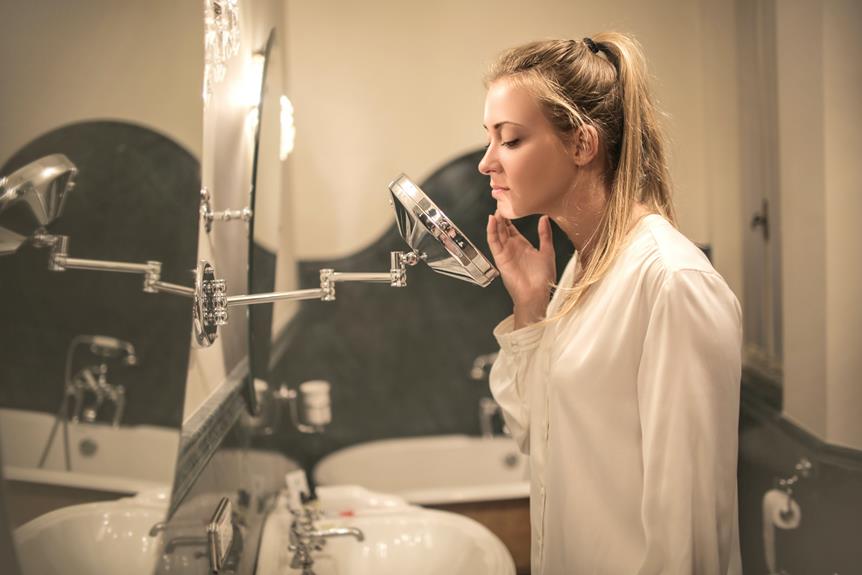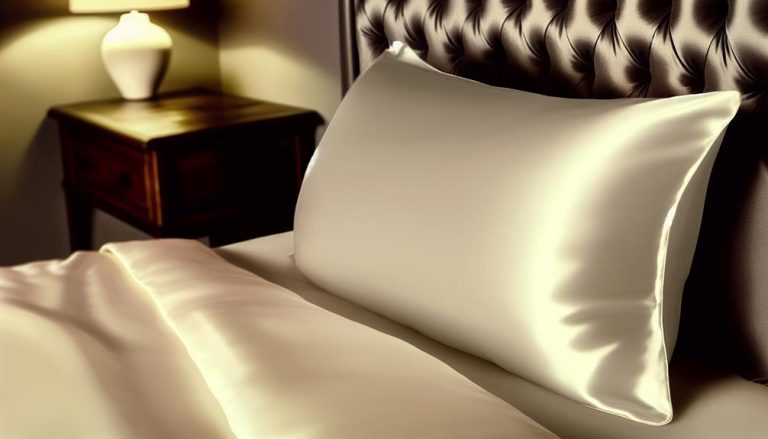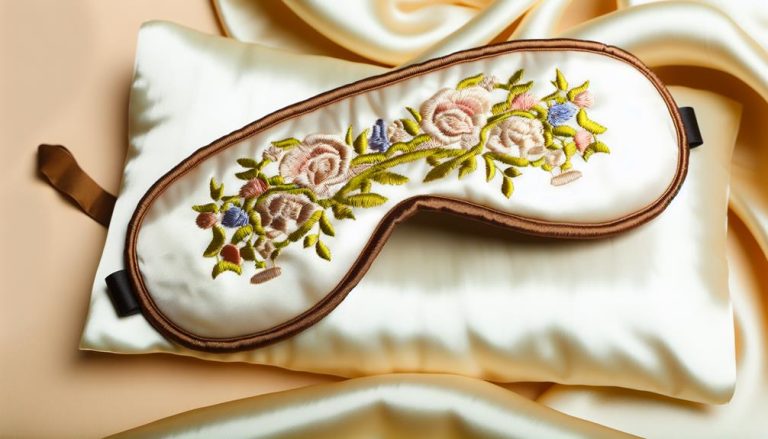Imagine waking up to a fresh, dewy complexion on Silk Pillowcases, free from the clutches of acne, having Clear Glowing Skin. It’s like stepping into a sunny meadow, where every petal glistens with radiant beauty.
If you’re on a quest for clear, glowing skin, then we have just the solution for you. In this discussion, we will uncover the best pillowcases that can help banish acne and unveil the skin of your dreams.
So, get ready to discover the secrets of silk pillowcases, the power of satin alternatives, and the hidden dangers lurking in synthetic materials. But that’s not all – we’ll also delve into the care and maintenance of these miraculous pillowcases, ensuring you reap their maximum acne-fighting benefits.
Stay with us, because the path to clear, glowing skin starts right here.
Silk Pillowcases for Clear Glowing Skin
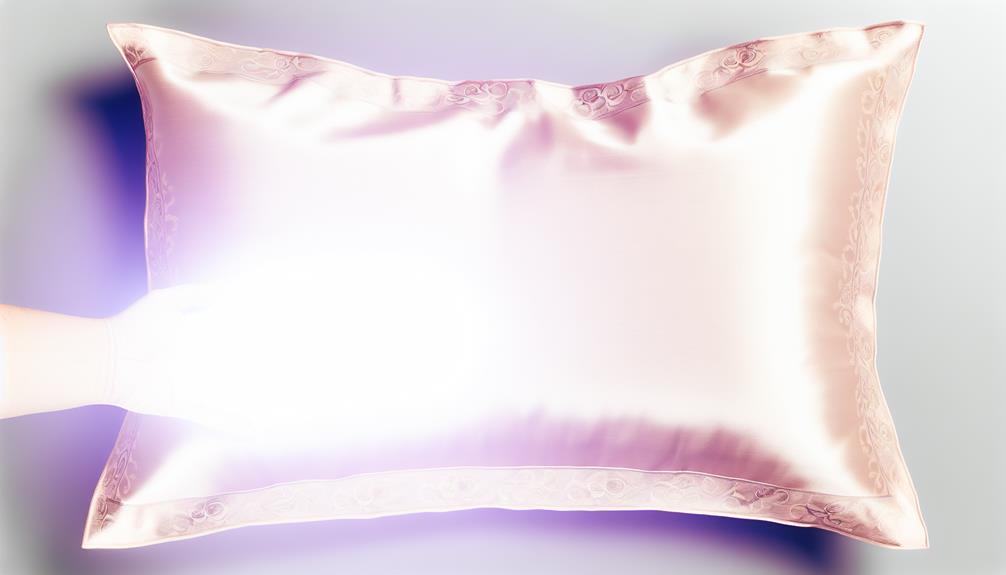
Silk pillowcases, made from pure mulberry silk, are a highly effective option for preventing acne breakouts and promoting healthier skin.
These luxurious pillowcases not only feel amazing against your skin but also provide numerous benefits for those seeking liberation from acne.
The smooth texture of silk resists dirt and debris, minimizing the chances of clogged pores and breakouts.
Additionally, silk pillowcases wick away moisture, keeping your skin dry and preventing the accumulation of natural oils that can contribute to acne.
Unlike satin or synthetic materials, silk is a natural fabric that requires specific care. Machine wash it on a gentle or delicate cycle with light detergent, and air dry for best results.
Satin Pillowcases and Acne
When it comes to acne prevention, it’s important to understand the difference between satin pillowcases and their effects on the skin. Satin pillowcases can be made from various materials like polyester, cotton, acetate, or rayon. Depending on the material used, satin pillowcases may collect skin cells and oil, which can be harmful to acne-prone skin. Satin refers to the weaving process, not the material used. A satin pillowcase could actually be made of cotton or other materials but has a sheen that resembles satin.
Satin pillowcases are sometimes mistaken as the best option for acne-prone skin, but this is due to a misunderstanding between satin and silk. Satin pillowcases made from synthetic materials may collect skin cells and oil, potentially leading to acne breakouts. Cotton and polyester pillowcases are rougher materials compared to silk, which can lead to hair damage and the emergence of cystic acne. Synthetic satin materials may not guarantee the same quality as natural silk pillowcases.
It’s crucial to choose a pillowcase that provides real benefits without causing damage to hair and skin.
Harmful Effects of Synthetic Satin Materials
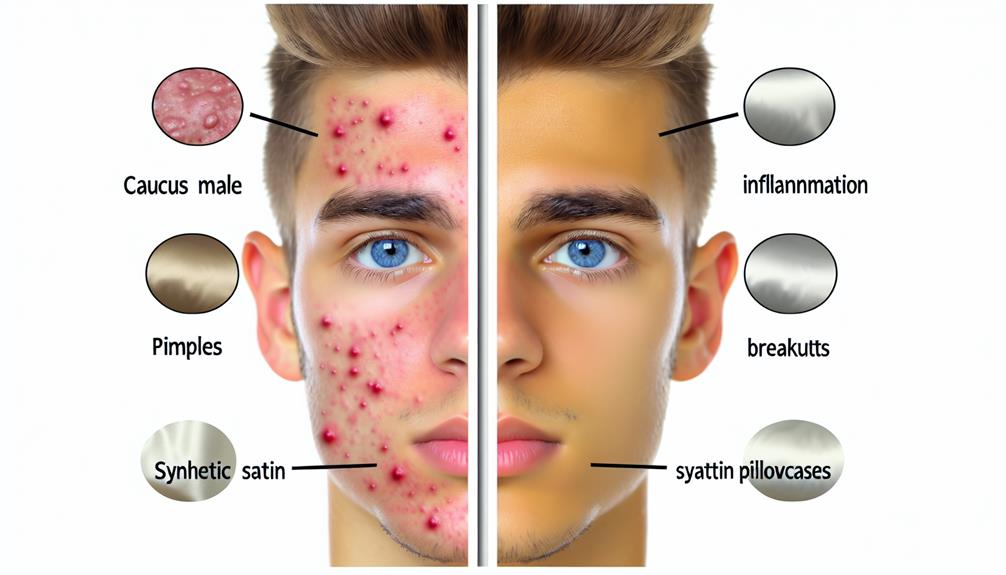
Synthetic satin materials can have harmful effects on the skin, potentially leading to acne breakouts and skin damage. Satin pillowcases, made from materials like polyester, cotton, acetate, or rayon, may collect skin cells and oil, which can be detrimental to acne-prone skin.
It’s important to note that satin refers to the weaving process, not the material used. A satin pillowcase could actually be made of cotton or other materials but has a sheen resembling satin. Synthetic satin materials, especially polyester, can harm the skin despite their satin weaving.
When it comes to pillowcases for acne, it’s crucial to choose ones that offer real benefits without causing damage to hair and skin. Synthetic materials may not guarantee the same quality as natural silk pillowcases, which provide a clean surface and absorb moisture, keeping the skin drier at night.
Cotton and Polyester Pillowcases and Acne
Cotton and polyester pillowcases aren’t recommended for acne-prone or sensitive skin due to their rougher materials that can lead to hair damage and the emergence of cystic acne.
When it comes to taking care of our skin, choosing the right pillowcase is crucial. Here are three reasons why cotton and polyester pillowcases may not be the best option for acne-prone skin:
- Rough Texture: Cotton and polyester pillowcases have a rough texture that can cause friction against the skin, leading to irritation and inflammation. This can worsen acne breakouts and make the skin more susceptible to bacterial infections.
- Absorption of Oils: Unlike silk pillowcases, cotton and polyester materials tend to absorb the natural oils produced by our skin. This can result in clogged pores and increased sebum production, leading to more acne breakouts.
- Lack of Breathability: Cotton and polyester fabrics aren’t as breathable as silk, which means they can trap heat and moisture against the skin. This environment is ideal for the growth of acne-causing bacteria and can exacerbate existing breakouts.
To ensure the best care for your acne-prone skin, opt for a pillowcase made from silk or other breathable materials that are gentle on the skin and hair.
Care and Maintenance of Silk Pillowcases
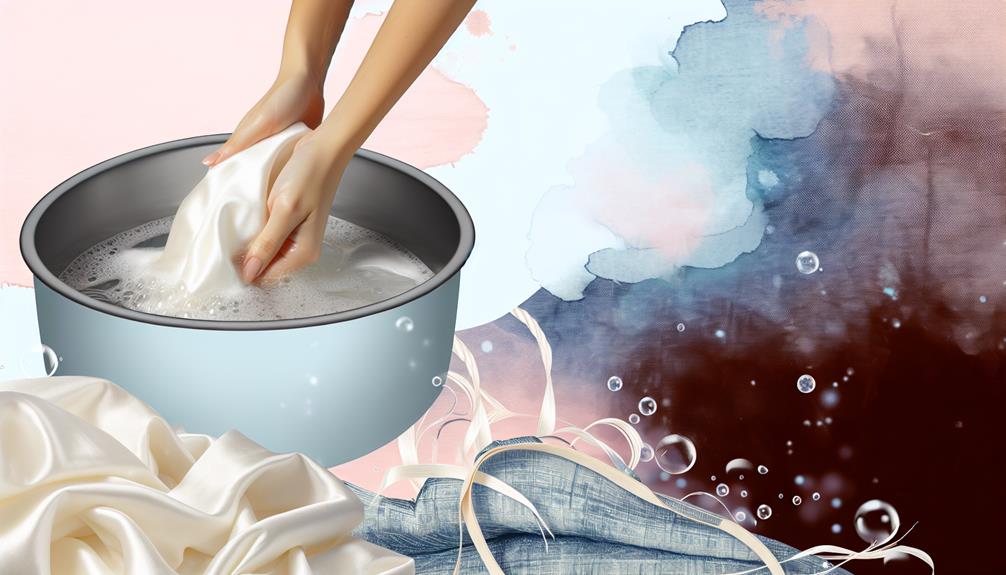
To maintain the benefits of silk pillowcases, it’s important to follow specific care instructions for this luxurious and acne-preventing material. Silk pillowcases are made from pure mulberry silk, a natural fabric that offers a clean surface for your skin and hair.
To keep your silk pillowcase in top condition, machine wash it on a gentle or delicate cycle using light detergent. Avoid using bleach or harsh chemicals that can damage the delicate silk fibers. After washing, air dry the pillowcase to prevent shrinking or warping.
It’s recommended to regularly wash your silk pillowcase to remove dirt, oils, and debris that can accumulate over time. By properly caring for your silk pillowcase, you can ensure its longevity and continue enjoying the benefits of clear, glowing skin.
Final Thoughts on Choosing the Best Pillowcases for Acne
When it comes to choosing the best pillowcases for acne, it’s important to prioritize materials like silk that resist dirt and debris, wick away moisture, and limit the accumulation of dust mites and natural oils. Silk pillowcases offer numerous benefits for acne-prone skin, such as minimizing breakouts and keeping the skin clear and glowing.
Here are some final thoughts to consider when selecting the best pillowcases for acne:
- Silk pillowcases are made from pure mulberry silk, a luxurious and natural material.
- Silk requires specific care, such as gentle machine washing with light detergent and air drying.
- Regular washing of silk pillowcases is necessary to maintain their benefits.
Frequently Asked Questions
Are Silk Pillowcases Only Beneficial for Acne Prevention or Do They Have Other Skincare Benefits as Well?
Silk pillowcases have numerous skincare benefits beyond just acne prevention. They’re made from pure mulberry silk, which resists dirt and debris, minimizing breakouts. Silk pillowcases also wick away moisture, limiting the accumulation of dust mites and natural oils.
Additionally, silk is a natural material that requires specific care, such as gentle machine washing and air drying. Regular washing of silk pillowcases helps maintain their benefits.
Can Satin Pillowcases Made From Natural Materials Like Cotton or Rayon Still Cause Acne Breakouts?
Satin pillowcases made from natural materials like cotton or rayon can still cause acne breakouts. Depending on the material used, satin pillowcases may collect skin cells and oil, which can be harmful to acne-prone skin.
It’s important to note that satin refers to the weaving process, not the material used. Satin pillowcases can be made of various materials, but they may not provide the same benefits as silk pillowcases.
To prevent acne breakouts, it’s best to opt for silk pillowcases made from pure mulberry silk.
How Often Should Silk Pillowcases Be Washed to Maintain Their Benefits?
To maintain the benefits of silk pillowcases, we should wash them regularly.
It’s important to keep them clean to prevent the accumulation of dirt and oils that can contribute to acne breakouts.
We recommend washing silk pillowcases on a gentle or delicate cycle with a light detergent.
After washing, let them air dry to preserve their quality.
Are There Any Specific Care Instructions for Silk Pillowcases to Ensure Their Longevity?
To ensure the longevity of silk pillowcases, it’s important to follow specific care instructions. Machine wash them on a gentle or delicate cycle with light detergent and air dry them. Avoid using harsh chemicals or bleach. Regular washing is necessary to maintain their benefits.
Additionally, silk pillowcases should be stored properly, away from direct sunlight and heat. By taking these steps, you can ensure that your silk pillowcases will last longer and continue to provide the desired benefits for your skin and hair.
Is It Necessary to Use Special Detergent When Washing Silk Pillowcases or Can Regular Laundry Detergent Be Used?
We recommend using a special detergent designed for delicate fabrics when washing silk pillowcases.
Regular laundry detergent may be too harsh and can damage the silk fibers.
Special detergents formulated for silk will help maintain the quality and longevity of the pillowcase.
They’re gentle and effective in removing dirt and oils without causing any harm.
Conclusion
In conclusion, when it comes to preventing acne and achieving clear, glowing skin, silk pillowcases are the best option. Their smooth texture resists dirt and debris, while also wicking away moisture and limiting the accumulation of dust mites and natural oils.
Satin pillowcases made from synthetic materials can potentially lead to more acne breakouts. By choosing silk pillowcases and properly caring for them, you can maximize their acne-fighting benefits and enjoy healthier skin.

